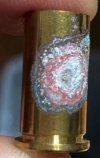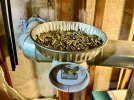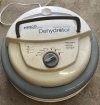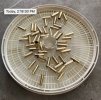hporter
Active Member
I find a case looking like this every once in a while when I pull them out of my brass storage containers to load.

This was a 38 S&W that I last shot out of my No.2 Enfield about 7 years ago. I wet tumbled them in plain water with stainless pins, a little car wash/wax and a teaspoon of citric acid.
This was back before I took the wife's old food dehydrator and bought her a new one. Now I stick them in the old food dehydrator and they are toasty hot and completely dry in 30-45 minutes.
Back then, I used to just shake all the water that I could, and leave the cases in the sun to dry. Out of 50 cases that I tumbled, this is the only one that suffered this condition. It was a once fired, from a batch of brand new Starline case.
It is no big deal - it only claims a case or two in every thousand. But I am genuinely curious to what might be the cause?
I've seen brass things with Verdigris on them, but nothing like this.
I thought I might ask the forum if someone might know?

This was a 38 S&W that I last shot out of my No.2 Enfield about 7 years ago. I wet tumbled them in plain water with stainless pins, a little car wash/wax and a teaspoon of citric acid.
This was back before I took the wife's old food dehydrator and bought her a new one. Now I stick them in the old food dehydrator and they are toasty hot and completely dry in 30-45 minutes.
Back then, I used to just shake all the water that I could, and leave the cases in the sun to dry. Out of 50 cases that I tumbled, this is the only one that suffered this condition. It was a once fired, from a batch of brand new Starline case.
It is no big deal - it only claims a case or two in every thousand. But I am genuinely curious to what might be the cause?
I've seen brass things with Verdigris on them, but nothing like this.
I thought I might ask the forum if someone might know?



